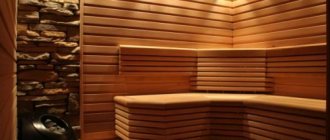Finnish sauna and Russian bath - similarities and differences
So, perhaps, the first difference between a Finnish sauna and a Russian bath is the principle of influence, which depends on the conditions created. Thus, the approximate temperature in a Finnish sauna is about 100–120 °C, and in a bathhouse – 60–70 °C. The operating principle of a Finnish sauna is dry air, while a Russian bath is steam. It follows from this that each steam room has its own effect on the human body.
If you ask the average visitor to steam rooms what is the difference between a sauna and a bathhouse, he will answer that in a Russian one it is not so hot and more humid. This opinion does exist, but rather exclusively in Russia. For example, Finns also like to steam in saunas with brooms and happily pour water on stones, despite the fact that this establishment is characterized by dry heat.
Temperature and humidity in a Finnish sauna
The Finnish sauna is a dry-air sauna , i.e. It is characterized by low humidity at very high air temperatures. Therefore, the sauna can be heated even up to 130? C , but only experienced sauna connoisseurs can withstand such “hellish” heat. The statistically average and most acceptable temperature for most visitors is considered to be from 70°C to 110°C, and its golden mean is 90 degrees Celsius. At such a high temperature, the humidity in the Finnish sauna room is no more than 10-15%. Even children and the elderly can tolerate this temperature quite comfortably.
Due to the low humidity, the human body tolerates air heating up to 110-120°C quite easily, although steam lovers often note dryness of the mucous membranes and respiratory tract, as well as a burning sensation in the nasal cavity.
If you feel that it has become too hot, go down to the bottom shelf and temporarily open the door to let out hot air and reduce the temperature in the room.
Distinctive features of the Russian bath:
- the temperature at head level does not exceed 60–65 °C, but in this air there is a higher concentration of steam than in a sauna;
- breathing in a Russian steam room with such indicators is very comfortable;
- the average temperature in the steam room is about 60–70 °C;
- average humidity level - 20%;
- in a bathhouse, the main operating factor is steam; the level of thermal conductivity of moist air is 1.5–2 times higher than dry air;
- against the background of high humidity in the steam room of a Russian bath, moisture from the body does not evaporate so quickly, and therefore the body warms up more thoroughly and effectively.
- Basic principles of visiting a Russian bath: consistency, gradualism, optimal tolerance.
In the classical sense, a Russian steam room is a wood-burning bathhouse, but the modern market has elevated steam rooms with heaters to the rank of relevant and universal ones. In fact, the heating technology is not a fundamental difference, therefore the presence of an electric stove is quite acceptable for a Russian bath. In addition, electric ovens are much simpler and more convenient to use.
It is believed that the Russian steam room in its properties is as close as possible to the natural conditions for the human body. Wet steam gradually affects the body and does not provoke a “shock” effect, which can sometimes occur in a Finnish steam room.
Although electric stoves cannot provide large clouds of beneficial smoke, you can practice aromatherapy, which saturates the air with beneficial components.
Sauna for weight loss
If you visit the sauna to lose weight, then again, once a week is enough. But in this case, it is not the quantity that is important, but compliance with the rules:
- for the purpose of losing weight, you should not cool down suddenly in a font, under a shower or in any other way;
- Between sauna visits, drink unsweetened diaphoretic tea. For example, herbal tea with honey;
- There is no need to visit the sauna on an empty stomach; you must eat 30-60 minutes before the sauna;
- There is no need to eat between sauna visits.
Go to the sauna for health!
Distinctive features of the Finnish sauna:
- dry air has lower heat capacity and thermal conductivity, and therefore temperatures of 100–120 °C are especially easily tolerated due to the relatively low humidity;
- humidity level - 5–10%;
- the average temperature in the steam room is about 100 °C;
- It is very important to add water to the stones correctly so that it does not lead to burns. The Finns do this slowly and in small portions, while the humidity increases for a short period of time;
- dry air gradually warms up the body, profuse sweating occurs, which is considered a kind of protection of the body from overheating.
Thanks to the active process of sweating, thermoregulatory functions are activated in the sauna, as a result of which waste and toxins are effectively removed from the body.
Stones are another difference between Russian and Finnish steam rooms. So, in a Russian bathhouse, the stones are located inside the stove behind a closed door, which is opened to add water. As a result, the stones heat up three to four times more than when they are lying on an open base.
In a Finnish sauna, the stones lie on the open surface, but they can be watered with water to also receive healing steam. True, such clubs quickly evaporate. Modern saunas use electric heaters with stones to heat the air. A distinctive feature of such a “firebox” is the ability to regulate the intensity of the furnace operation and select the optimal temperature level.
Rules for visiting the sauna
The Finnish steam room differs from the Russian bath in that a person steams at a temperature of 65 to 100 degrees in dry air. Because of this, you cannot use a bath broom in it, as it can leave burns on the body. The rules for using the sauna provide for only one type of relaxation in the steam room: lying on the shelves and calm relaxation.
It is customary to cool off in a sauna in a cool pool, since the key effect on the body is based on the alternation of a hot atmosphere in a steam room with cooling in water. These temperature changes help strengthen blood vessels and improve the health of the circulatory system. With regular and proper use of the sauna, blood vessels become more flexible, and blood flow improves in the limbs.
Steaming in a Finnish sauna is useful at the first symptoms of a cold. In the steam room, the human body is artificially introduced into a state of hyperthermia (increased body temperature), which is an important factor in the fight against colds. The immune system instantly reacts to an artificial increase in body temperature, which begins to produce an increased number of white blood cells and antibodies, rushing to the source of the disease to overcome it.
Professional athletes use the beneficial properties of the sauna to relieve muscle tension after grueling strength training. After a short rest in the Finnish steam room, athletes feel refreshed and full of energy again. This pleasant procedure helps to deeply relax and, as they say, “clear your head.”
Actively reacts to the conditions of the steam room and our skin. As a result of high temperature, blood circulation increases in the skin. The surface of the body can even warm up to 42 degrees. Following the expansion of blood vessels, the skin becomes softer and more sensitive, and its immunobiological properties increase.
Visually, this is reflected in improved skin color and extraordinary softness and tenderness. Women will appreciate that with the help of a sauna they can control their weight. Even after just one proper visit to a Finnish sauna, a person’s weight becomes 2% less due to the removal of stagnant fluid from the body.
The first thing you need to do before entering the steam room is to take a warm shower to wash off the sweat and dust that has accumulated on your skin during the day. But you need to wash without using soap or shower gel. Otherwise, they will wash away the fatty film from the body, and this will become an obstacle to profuse sweating in the steam room.
Before entering the hottest room of the sauna, do not forget to take care of the safety of your hair and the safety of your head. To avoid harm to your health, never enter the steam room with a wet head, as this will increase the heat load on the blood vessels in it. The still hot sauna air can damage the hair structure in a few minutes, making it dry and brittle.
Proper relaxation in the sauna requires vacationers to have several required items:
- felt bath cap;
- towel;
- sheet;
- rubber slippers.
A felt sauna cap will help protect your hair and head from the heat in the sauna, as it maintains a constant comfortable temperature under it. As a last resort, wrap a dry terry towel around your head, but entering the steam room with your head uncovered is prohibited by the sauna rules.
Ideally there should be two towels: for the body and separately for the face. You may need a small towel not only for performing cosmetic procedures, such as applying masks, but also for wiping sweat from your face in the steam room. You will need a sheet to cover the lounger in the steam room of the sauna and avoid steaming on a hot surface that can burn your skin.
Rubber slippers are useful in a public Finnish bathhouse so as not to walk barefoot on the tiled floor when going to the pool or shower room. But you cannot go into the steam room in them, since under the influence of high temperatures the rubber can begin to release harmful toxic substances into the air. The correct thing to do would be to leave them outside the steam room door.
We suggest you familiarize yourself with How to heat a Russian stove: how to properly heat it with wood
As in a Russian bath, in the steam room of a sauna the air temperature is different on the shelves installed at different levels from the floor. During your first visit, do not rush to occupy the highest and hottest shelf, but rather sit for a few minutes on the lowest one to allow your body to get used to the new temperature conditions.
Proper use of the sauna requires a person to follow a few simple rules so as not to harm their health. First of all, you need to forget about alcoholic drinks on the day you decide to take a steam bath. Alcohol dehydrates the body, and in a sauna this can result in increased stress on the heart and drowsiness.
Before, during and after the sauna, do not forget to drink plenty of clean water or herbal infusions to promptly replenish fluid loss. In a sauna, the sweat glands are capable of releasing 10–30 grams of sweat within one minute! Therefore, if you steam and do not drink water, dehydration can occur very quickly. With a loss of just 1% of fluid, the body can begin to signal the danger of dehydration with a wave of fatigue. With severe water fasting, a person may become dizzy and his heart rate will go off scale.
Before you go to steam, you should not eat a lot so that the body does not have a double load. The sauna is not recommended for people suffering from chronic low blood pressure. In the steam room it will decrease even more.
Many gynecologists do not recommend bathing procedures for women during pregnancy, since high temperatures pose a risk to the baby in the womb. The exception is pregnant women who have been visiting the sauna for years, and only if their attending physician allows them to steam. A similar precaution applies to women during breastfeeding.
Pediatricians do not allow children to bathe until they reach the age of six. Babies have a limited ability to tolerate high temperatures because they have a thin subcutaneous fat layer and an immature excretory system. But if the parents are avid sauna attendants, then you can gradually accustom the child to going to the sauna at an earlier age.
The list of contraindications to visiting the sauna includes the following health problems:
- oncological diseases;
- exacerbation of any chronic diseases;
- elevated temperature;
- active tuberculosis;
- severe vascular atherosclerosis;
- menstruation in women;
- thrombosis;
- tendency to bleed;
- infectious skin diseases.
The list of contraindications also includes hypertension. But some doctors allow patients suffering from high blood pressure to occasionally visit the sauna. One visit to the steam room should not exceed 10 minutes.
Before visiting the sauna, it is recommended to remove all metal jewelry from the body, and women should remove hair clips. They will heat up in a hot steam room. And if you immediately feel the hot rings or chain and remove them before they become scalding, then you will not notice the effect of the hot metal hairpin, and it will harm your hair.
You can steam for no longer than 15 minutes at a time if you feel that the temperature in the steam room is beyond your capabilities. But if, for example, you usually steam at a temperature of 90 degrees, but find yourself in a Finnish sauna with a temperature of 75 degrees, then you can relax in the steam room longer than the specified time. But even in this case, you should not experiment, trying to find out how long you can sit in the steam room. You can stay in a hot sauna room as long as this relaxation brings you pleasure.
At the first signs of discomfort (nausea, darkening of the eyes, dizziness), you should immediately go to the rest room to cool down. But don't make sudden movements. If you were lying on a shelf, then slowly rise up and sit for 20 seconds before standing up. A sudden change in body position from horizontal to vertical in a sauna can lead to fainting.
If you are a seasoned, experienced bathhouse visitor, then you can afford sudden temperature changes and throw yourself into a cold pool or wipe yourself with snow in winter. If you are not used to such extreme winter fun, do not copy the actions of other people, but steam and cool off in a way that is comfortable for you.
Alternative opinion of bath experts
Some experts who study the principles of the effects of steam on the body agree: there are no significant differences between the Finnish sauna and the Russian steam room. Finns enjoy pouring water on stones and steaming with healing brooms. And the difference in humidity and temperature is not so great as to have a radically different effect on the body.
The Finns themselves do not consider their sauna dry. In their opinion, with the correct organization of the process, it is possible to achieve optimally moist steam, in which it will be easy to breathe, and high temperatures will be perceived by the body quite adequately.
But most bath experts still note differences between steam rooms, at least in terms of activity level. For example, a Finnish sauna involves being in a calm state: a person mainly lies or sits, trying to relax as much as possible. In a Russian steam room, guests steam with brooms, add steam, wash, and relaxation sets in after they leave the steam room.
Benefit for health
What are the health benefits of a Finnish sauna? Doctors consider the Finnish sauna an excellent way to cleanse the body of toxins and restore muscle function. Therefore, visiting the sauna is recommended after training and any sports activities. The sauna helps you relax, relieve stress, and of course, has a positive effect on the skin.
It is known that our skin reflects our overall health. You can judge a person’s health by the color of the skin, its firmness and elasticity, greasiness and moisture, as well as the thickness of the layers. It is believed that healthy skin should have a pink tint due to good blood supply.
Vegetable diet for weight loss
The Finnish sauna improves blood supply to the skin and gives a positive cosmetic effect without any allergies, unlike many cosmetics. The Finnish sauna is good for the skin even with diseases: psoriasis, urticaria, eczema, furunculosis, acne, non-healing scars and wounds.
About the effect of a steam room on the body
The main task of a steam room in a bathhouse is to warm up the human body so as to cleanse it of toxins and waste. All harmful components come out during active sweating through the pores of the skin.
However, extremely high temperatures can lead to tissue shock. That is why the milder conditions of a Russian bath are better than the extreme effects of a Finnish sauna. Humidity in a Russian bath ranges from forty to seventy percent. In combination with the “tolerable” heat, the bath gradually warms up the body without provoking vascular spasms or arrhythmias. These conditions allow even people suffering from high blood pressure and heart problems to receive health treatments. The Russian bath helps with respiratory diseases, increases the vital capacity of the lungs and restores the mucous membrane.
The dry steam of a Finnish sauna also has its advantages. In a stressful situation, the body's systems are mobilized and increased sweating begins. The sauna maintains a stable temperature and humidity. However, visiting a Finnish steam sauna is not recommended for patients with poor health. Hot, dry air can cause severe coughing and dry mucous membranes.
The sauna and its dry heat are excellent for treating diseases of the genitourinary system, liver problems, pyelonephritis, skin diseases and colds. The Finnish sauna is contraindicated for tuberculosis, hypertension, lung disease and nervous disorders.










